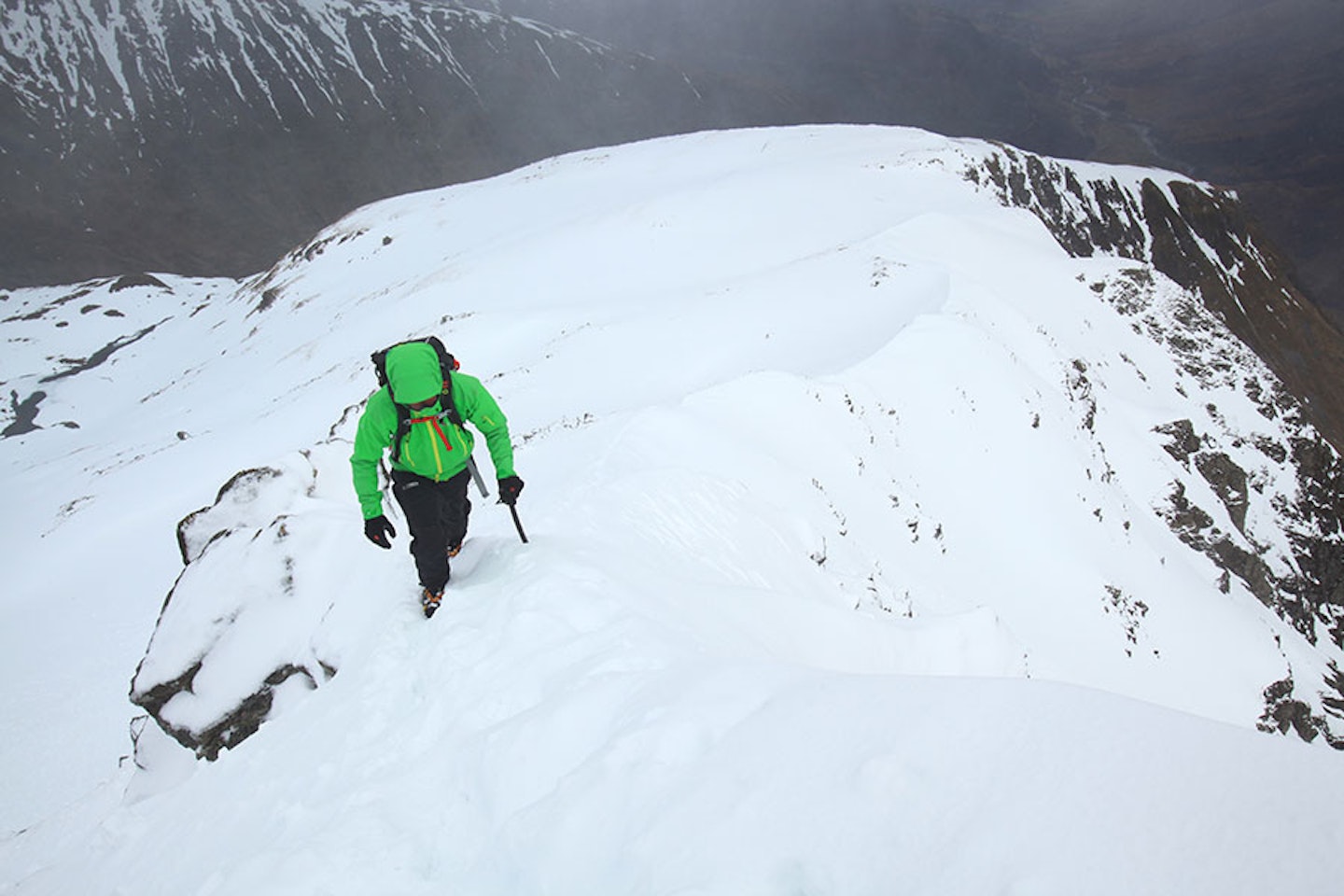Distance 11km | Ascent 1150m | Winter rating Grade 1 | Go there when winds are low and the snow is reliable
See our Winter Survival Guide and Useful Winter Resources lists after the route description.
When winter hits the hills around Fort William, walkers looking for adventure with a little cold weather frisson will, more often than not, head straight to the Carn Mor Dearg Arête ascent of Ben Nevis. It is after all one of the most well-known ridge traverses on the UK mainland, managing to be both airily exciting and relatively straightforward at the same time. But what if you’ve already done it and fancy a change? What if you want a bit more time and space to yourself, rather than joining the cramponed queue along the arête? What if the weather and avalanche forecasts simply put that side of The Ben out of bounds? Whatever the reason, as luck (or rather geology) would have it, there’s a suitably rewarding alternative just over the other side of Glen Nevis.
Stob Ban sits among The Mamores, just off the Ring of Steall route. Its closeness to Ben Nevis and the fact its summit is not part of the classic Steall round means it doesn’t get a fraction of the traffic it deserves. Which is great news if you prefer your hills to yourself. Stob Ban translates as ‘White Peak’, due to the pale quartz that tops the mountain. And in winter, when the snow hiding the quartz makes this Stob even more Ban, its entertainingly scrambly north ridge becomes a snowbound epic that will leave you wondering why it’s not top of the tick-list of every would-be winter adventurer.
As with all winter routes though, conditions are everything. Get the latest information from the Scottish Avalanche Information Service at sais.gov.uk and never be afraid to amend or abandon your plans accordingly.
1.
The walk starts along a vehicle track (unmarked on OS Maps) at NN143684. There’s a small parking area just west of the gate and a larger one 150m to the east. Follow this track until it runs out, turning in to a small path which winds through boggy ground towards Sron Dearg.
WINTER ADVICE: You start at just 50m above sea-level. Stob Ban’s summit is 999m above sea-level. Don’t be lulled into a false sense of security in the car park – it will be colder and wilder nearly a kilometre higher.
2.
Climb steeply up the north-eastern nose of Sron Dearg, though crags and onto the broad, gently ascending spur of Stob Ban’s north ridge. Take time to admire the sculpted corries to your left and over to the right, and the increasingly impressive view of Ben Nevis behind you.
WINTER ADVICE: The initial ascent up Sron Dearg is steep and conditions may still be mild. Vent your clothing and adjust your layers so as not to build up a sweat which could be unpleasantly – and potentially dangerously – chilling higher up.
3.
The ridge flattens and broadens – but this is only temporary and the ground between here and the top is more serious. It’s a good place to stop, put on crampons if required, and drink and eat to top up your fuel levels.
WINTER ADVICE: Look ahead to check for cornices along the ridge and around the summit. They are most likely to be on the north-east facing edges.
4.
Begin the scrambly ascent, staying as close to the apex of the ridge as possible. If the snow is deep the rocks may be invisible and you’ll be traversing an arête seemingly made entirely of snow. The western side is the less severe, but keep that axe in hand and ready to use; any slide resulting from a slip has the potential to be a long one.
**WINTER ADVICE:**Don’t assume there’s solid ground under the snow you’re about to stand on. Look at the mountain around you to work out the lay of the land (you’ve already checked for cornices) and use your axe to probe through the snow.
5.
From the 912m spot-height a final pull up steep but easy ground takes you to Stob Ban’s summit cairn, which may be buried. Be sure to keep a good distance away from the steep cliffs of the mountain’s north-east face as there are likely to be large cornices here. With the Munro summit bagged, head back down towards the 912m spot-height and the start of the onward route west.
WINTER ADVICE: Wind scoured western slopes may offer firmer neve – compacted frozen snow which is easier to walk on with crampons than loose powdery snow.
6.
Follow the ridge west, at first dropping slightly to a shallow saddle, then climbing to a 917m subsidiary top with a short scrambly descent before continuing on to the 939m summit of Mullach nan Coirean. The slopes to your left are long and continuous, while to your right will be the steep crags that plunge into the bowl of Coire Dearg. Again, be aware of cornices on these northern edges.
**WINTER ADVICE:**Cracks in the snow that run parallel to the edge can indicate where overhanging cornices will break from the snowpack, and are best kept away from.
7.
Mullach nan Coirean’s summit has a large cairn which can offer a little shelter as you fuel up for the final descent. Follow the summit ridge north before descending east, then north-east down the scrambly spur that forms the southern boundary of Coire Riabhach. Take the track over the Allt a’ Choire Riabhach, into the forestry and towards the Allt a’ Choire Dheirg, which can be followed north back to the small car park by the start.
WINTER ADVICE: If the ridge descent looks tricky or too banked out with snow, it may be better to continue descending to Glas Chreag and then down its north-eastern nose alongside the burn (avoiding the crags) and into the forestry.



Winter ridge survival kit
Always check the weather and avalanche forecasts and amend your plans accordingly.
Be aware of the shorter daylight hours and carry at least one torch.
Ensure you let someone know where you’re going and when you’ll return.
Never be afraid to turn back if conditions aren’t right.
Only attempt a winter route if you have an ice axe, crampons, and the skills to use them.
Consider hiring a winter mountain leader if you’re unsure of your own capabilities.
Useful winter resources
The British Mountaineering Council: thebmc.co.uk/winter-climbing-and-walking-skills
Mountaineering Scotland: mountaineering.scot/safety-and-skills/thinkwinter
Mountain Weather Information Service: mwis.org.uk
Scottish Avalanche Information Service: sais.gov.uk

Discover great hill and mountain walking routes like this in every issue of Trail Magazine


